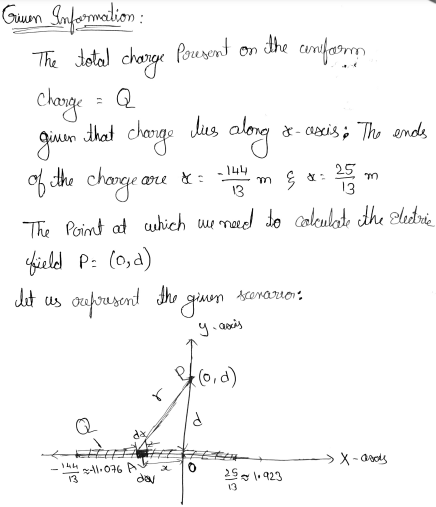A uniform charge distribution of total charge Q (Q>0) is located along the x-axis. The left end of the charge distribution is located at x=-(144/13)m and its right end is located at x=(25/13)m. Our goal is to calculate the electric field at point P which is located at (x,y)=(0,d). Use letters k for the Coulomb constant, Q for the total charge, d for the y-coordinate of point P, and x and y, for the cartesian coordinates in your responses. (a) Determine the expression for dq. (b) Determine the expression for r2, the magnitude of the vector that is directed from the element of charge dq to the location in which the field is to be determined. (c) Determine the expression for r̂ the unit vector that is directed from the element of charge dq to the location in which the field is to be determined (d) Write the expression for d due to the element of charg
A uniform charge distribution of total charge Q (Q>0) is located along the x-axis. The left end of the charge distribution is located at x=-(144/13)m and its right end is located at x=(25/13)m. Our goal is to calculate the electric field at point P which is located at (x,y)=(0,d). Use letters k for the Coulomb constant, Q for the total charge, d for the y-coordinate of point P, and x and y, for the cartesian coordinates in your responses. (a) Determine the expression for dq. (b) Determine the expression for r2, the magnitude of the vector that is directed from the element of charge dq to the location in which the field is to be determined. (c) Determine the expression for r̂ the unit vector that is directed from the element of charge dq to the location in which the field is to be determined (d) Write the expression for d due to the element of charge dq. (e) Let d=(60/13)m. Integrate the expression to determine the electric field at P. Perform this integration by hand. Avoid using online resources to evaluate the integral. (f) Calculate the magnitude of the electric field.
Hi there! Since there are multiple subparts in the question posted and it is not mentioned what is to be answered, we are providing the solution for the first 3 subparts. If the solution for a specified subpart is required please repost the question, specifying the particular subpart. Thank you!

Step by step
Solved in 4 steps with 4 images









